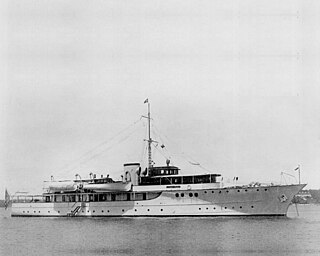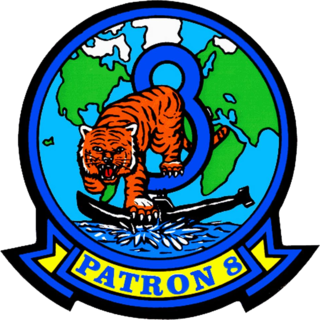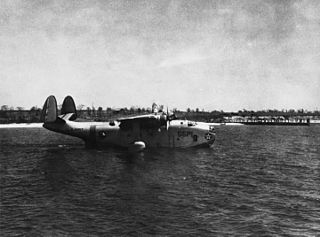
USS Patoka (AO–9/AV–6/AG–125) was a replenishment oiler made famous as a tender for the airships Shenandoah (ZR-1), Los Angeles (ZR-3) and Akron (ZRS-4). It was also notable in that its height figured prominently in the design of Rainbow Bridge in Texas.

USS Du Pont (DD–152) was a Wickes-class destroyer in the United States Navy during World War II, later reclassified as AG-80. She was the second ship named for Rear Admiral Samuel Francis Du Pont.
USS Carnelian (PY-19) was a converted yacht that patrolled with the United States Navy in World War II. She was named for carnelian.

USS Goldsborough (DD-188/AVP-18/AVD-5/APD-32) was a Clemson-class destroyer in the United States Navy during World War II. She was the second Navy ship named for Rear Admiral Louis M. Goldsborough (1805–1877). Entering service in 1920, the ship had a brief active life before being placed in reserve in 1922. Goldsborough was reactivated for World War II and was used as an aircraft tender, destroyer and high speed transport in both Atlantic and Pacific theaters. Following the war, the ship was sold for scrapping in 1946.

The first USS Lardner (DD-286) was a Clemson-class destroyer in service with the United States Navy from 1919 to 1930. She was scrapped in 1931.

The third USS William C. Lawe (DD-763) was a Gearing-class destroyer of the United States Navy, named for aviation metalsmith third class (AM3c) William C. Lawe (1910–1942), who was killed on June 4, 1942, as a member of Torpedo Squadron 8 (VT-8) in the Air Battle of Midway.

USS Thrush (AM-18) was a Lapwing-class minesweeper acquired by the United States Navy for the dangerous task of removing mines from minefields laid in the water to prevent ships from passing.

The American motor yacht Haida was built in Germany in 1929 for Max C. Fleischmann and later saw service in the United States Navy during World War II as patrol yacht USS Argus (PY-14) and USC&GS Pioneer. In 1946 she returned to her role as a private yacht under a sequence of names and owners, and after a further refit in 2016 is now Haida 1929.

USS Moonstone (PYc-9) was a coastal patrol yacht in the service of the United States Navy. She was built in 1929 as Nancy Baker by Germaniawerft in Kiel, Germany, later renamed Mona, and subsequently acquired by the Navy as the Lone Star on 10 February 1941. Renamed Moonstone and designated PYc-9, she was converted for U.S. Navy service in Jacksonville, Florida, and commissioned on 10 April 1941. She was named for the gemstone moonstone.

Chachalaca (AMc-41) was an Accentor-class coastal minesweeper built by the Bristol Yacht Building Company, South Bristol, Maine and delivered to the U.S. Navy at the Boston Navy Yard in August 1941.

The sixth USS Niagara (SP-136), later PY-9, was a United States Navy patrol vessel in commission from 1918 to 1931 and which served during World War I.
USS PC-568 was a PC-461-class submarine chaser built for the United States Navy during World War II. The ship was later named USS Altus (PC-568) in honor of Altus, Oklahoma, but never saw any active service under that name. After she was struck from the Naval Vessel Register in 1963, she was transferred to the United States Air Force.

Patrol Squadron Eight (VP-8) is a U.S. Navy land-based patrol squadron stationed at Naval Air Station Jacksonville, Florida (USA). VP-8 is tasked to undertake maritime patrol, anti-submarine warfare (ASW), and intelligence, surveillance and reconnaissance (ISR) missions. The Squadron is equipped with the Boeing P-8A Poseidon.

USS Opal (PYc-8), formerly the yacht named Coronet (1928), was a patrol boat in the United States Navy during World War II and then served in the Ecuadorian navy.

USS Valiant (PYc-51), originally USS PC-509, was a United States Navy patrol vessel in commission from 1941 to 1944.

USS Sylph (PY-12), briefly YP-71, was a yacht in commission in the United States Navy as a Patrol Yacht from 1940 to 1946.

USS Tourmaline (PY-20) was a converted yacht that patrolled with the United States Navy in World War II.

USS Ruby (PY-21) was a converted yacht that patrolled with the United States Navy in World War II.

VP-40 was a Patrol Squadron of the U.S. Navy. The squadron was established as Patrol Squadron 55 (VP-55) on 1 August 1940, redesignated Patrol Squadron 74 (VP-74) on 1 July 1941, redesignated Patrol Bombing Squadron 74 (VPB-74) on 1 October 1944, redesignated Patrol Squadron 74 (VP-74) on 15 May 1946, redesignated Medium Patrol Squadron (Seaplane) 10 (VP-MS-10) on 15 November 1946, redesignated Patrol Squadron 40 (VP-40) on 1 September 1948 and disestablished on 25 January 1950.

Patrol Squadron 45 (VP-45) is a maritime patrol squadron of the United States Navy. The squadron was established on 1 November 1942 and is based at Naval Air Station Jacksonville, Florida, United States. Since 2014, VP-45 is equipped with the Boeing P-8 Poseidon aircraft.


















